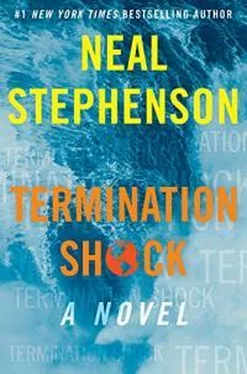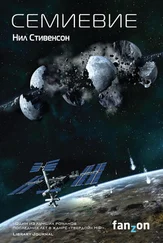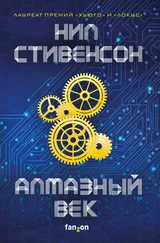PINA2BO
Rufus dug the silence of it. Oh, the sonic booms still crackled over the mountains every eight minutes. You had to get used to that. But the recovery was as peaceful as you could imagine. Suspended from their paragliders, the shells came gliding in over the Rio Grande. They didn’t cross the river until they were just a few hundred feet above the ground. By that point each was aiming for a specific net. There were four nets operational when Rufus first arrived, with four more getting their finishing touches. They were spaced up and down the length of a new road running along the top of a mesa that rose a few hundred feet above the river.
Each net was square, about half the size of a football field. It was suspended at each of its four corners from a steel pole that projected to a height of maybe fifty feet from a concrete footing in the ground. The setup couldn’t have been much simpler: At the top of each pole was a pulley with a steel cable running over it. One end of that cable was carabinered to a corner of the net. The other end ran down the pole to ground level where it disappeared into a winch. When all four cables were winched tight, the net stretched overhead like a roof, sagging a bit in the middle, but nowhere less than about thirty feet above the ground.
The empty shells coasted in from their sojourn in Mexican airspace, each vectored to a particular net. If the wind wasn’t blowing and you listened carefully, you might just be able to hear a faint flutter in the parasail, or singing in the shroud lines. When the shell sensed it was over the middle of the net it would actuate a mechanism that detached it from the parasail with a faintly audible mechanical snick, and it would drop, bounce once or twice, and come to rest at the bottom of a mesh funnel, so close to the ground you could almost touch it. The parasail would crumple and glide away on the wind like a puff of smoke. There was a team called sail chasers who would follow it across the mesa on ATVs until it came to earth, then wrestle it into a stuff sack. Meanwhile another team called net runners would unreel one or two of the winch lines, lowering the net. When the shell was on the ground, they would simply walk out, pushing a four-wheeled dolly, and pick it up. At this point in its duty cycle, after it had jettisoned its sabot, nose cone, and parasail, and burned its load of sulfur, the shell was light enough that a crew of two could lift it off the ground and deposit it on the dolly.
It took hours for these things to spiral down from the stratosphere. During that time the shell had cooled off and purged any lingering fumes of SO 2. The net runners would push the dolly over to a waiting trailer and hoist it into a cradle. Then they’d use the winches to reinstate the net. Downtime for a given net was rarely more than a few minutes. When a trailer got full of spent shells, a truck would drive up, hitch on, and tow it north to one of the installations that had been built along the arc road around Pina2bo. There each shell would be inspected and refurbished and sent empty to Pina2bo itself, where it would sit in the queue awaiting its next flight. Only at the last minute was the hot liquid sulfur piped into its tank.
Meanwhile a steady flow of parasail stuff sacks was accumulating in another trailer. When full, these were driven off the ranch and down the interstate to El Paso and across the bridge to Juarez, where they were unloaded in an air-conditioned maquiladora . Rufus hadn’t visited that place, but they’d showed him videos. Employees in white coveralls pulled out the crumpled parasails, spread them across huge clean tables, inspected them for scorpions, plucked out cactus spines, mended rips, and then carefully re-packed them so that they would deploy correctly the next time they were used. In due course they were trucked back to Flying S and installed in refurbished shells.
Sabot catchers and cone hunters were two other categories of employee. Their jobs were similar in some ways, different in others. The sabot enclosed the base of the shell during its passage up the gun barrel and fell off immediately afterward. It was made of some foamy ceramic, heat-resistant but lightweight and reasonably hardy. Most of them tumbled to the ground within a couple of hundred meters of the gun. Much of that area was under suspended nets with ribbons of fabric woven through them, which performed multiple roles: casting shade, providing some privacy, stopping any unwelcome low-flying drones. And, of course, catching sabots. As such, much of the sabot catchers’ work had to do with those nets. If wind was steady, the sabots all fell in the same general area. As a rule the sabot catchers never ranged as much as half a mile from the gun.
The nose cones were jettisoned at much higher altitude. Depending on wind, they could land practically anywhere on the ranch. Many were simply lost. Supposedly they were biodegradable, though in the Chihuahuan Desert there wasn’t a whole lot of bio to do the degrading. They sent out radio pings until the batteries died. Their bright orange color made it easy to see them from drones, and some of the propellerheads at White Label had ginned up a machine-learning program that could scan through aerial images and identify possible strays. That information was piped through to HUDs in the cone hunters’ earthsuits, to make their work more efficient.
On the nominal firing cadence of one shell every seven and a half minutes, Pina2bo launched 192 shells a day, and so that was the number of nose cones that, on average, fell to earth every twenty-four hours. Most of the cone hunters were Mexican American and many had worked in agricultural settings where they would be paid by the number of apples picked or heads of cauliflower harvested. Gunning ATVs across the desert “harvesting” strewn nose cones was in some ways similar, though both more fun and more dangerous. The best of them, working in two-person teams, recovered twenty cones a day, though that number was slowly trending upward as they learned the tricks of this new trade.
Rufus—who spent his first week on the ranch simply driving around and observing all this—had it in mind to sit down and spreadsheet it and figure out the size of the operation. At the mesa above the Rio Grande, typically they had two pairs of net runners, leapfrogging from net to net depending on where the next shell was coming in, and three pairs of sail chasers. One or two truck drivers seemed to be on call to ferry the loaded trailers and bring back empties. The sabot-catching could be handled by one person. Maybe eight pairs of cone hunters worked during the daylight hours. He had no idea how many chute packers worked in Juarez.
At Pina2bo proper there were the kinds of jobs typical of the oil business and of the chemical industry downstream of it. Unloading bulk sulfur from hopper cars and melting it was child’s play, mostly automated. Natural gas came in via pipeline from wells elsewhere on the ranch and was either shunted directly to the guns, or diverted to the cracking facility, where hydrogen gas—along with a concomitant amount of carbon black—was produced. This was a significant piece of infrastructure, but being a new facility it too was mostly automated, and controlled by engineers from the same bunker where they operated the gun. Likewise, the process of prepping the shells and slapping on the nose cone and sabot, mating it with the pre-packed parasail, running pre-launch checks on the electronics, filling it with hot sulfur, and putting it on the shell hoist—that was all done by robots. So one of the surprises for Rufus during these early days of wandering around and getting to know the operation was just how lightly staffed the actual gun complex was.
That—plus a few mission control types keeping an eye on things in Houston—was the operational side of Pina2bo. Everything else was classed as support. The ranch was so remote and the conditions so inhospitable that it might as well have been on Mars. So “support” had to include things like: Where could employees get food? How could they put gasoline or diesel in the tanks of their vehicles? What would they do if they had a medical problem? In that way it was different from an urban company where the city would just supply all that. It was, though, perfectly familiar to the oil business, where it was common for workers to live on offshore rigs or other remote installations for months at a time. So that stuff was all subbed out to companies that simply did that kind of thing. Roughly speaking, Rufus guessed that there was one support worker for every one on the operational side. With the exception, that is, of security, which was technically under Support but for various good reasons was a whole department unto itself.
Читать дальше

![Нил Стивенсон - Криптономикон [litres]](/books/23868/nil-stivenson-kriptonomikon-litres-thumb.webp)







![Нил Стивенсон - Лавина [litres с оптимизированной обложкой]](/books/414066/nil-stivenson-lavina-litres-s-optimizirovannoj-ob-thumb.webp)
